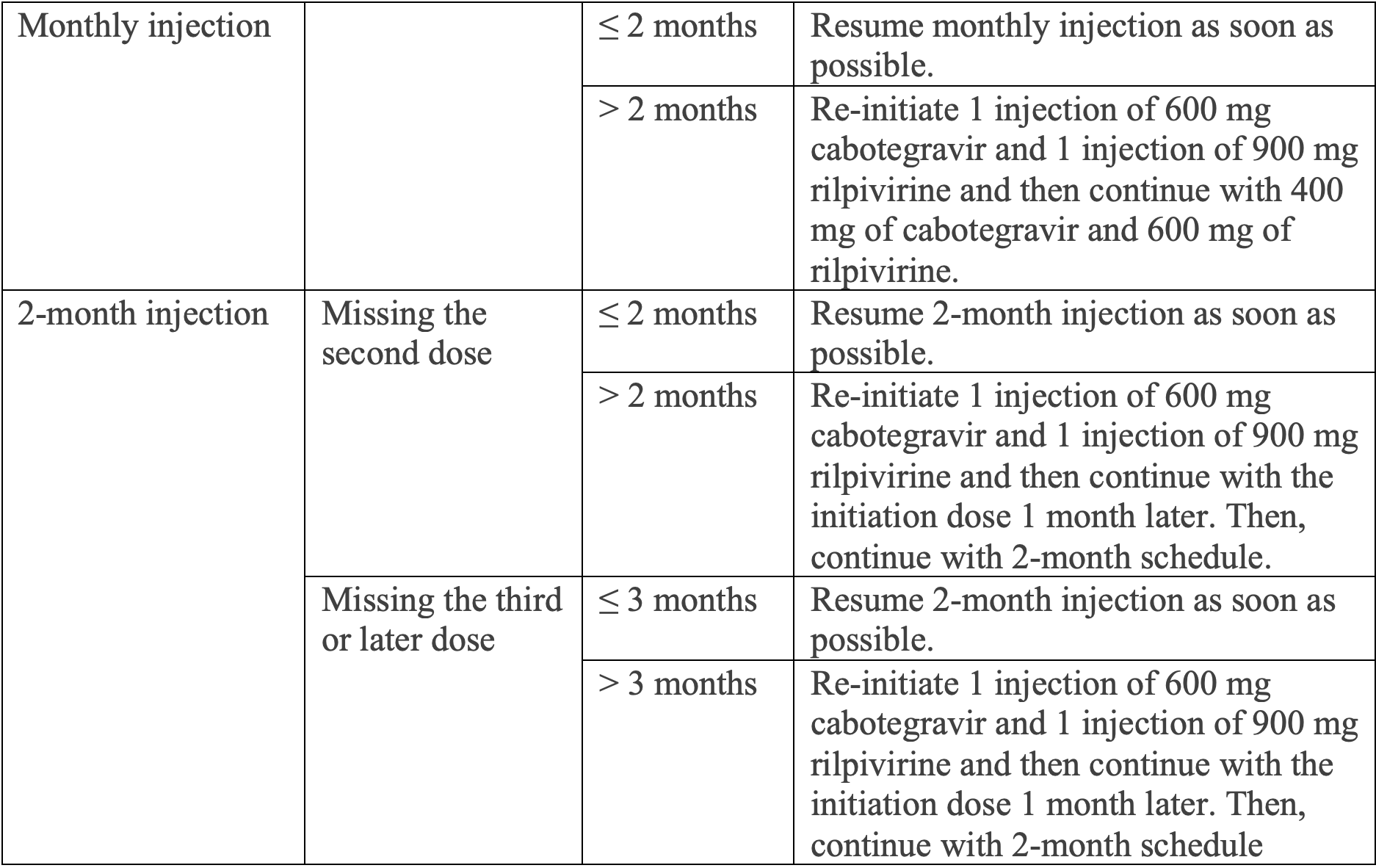Article
Clinical Overview: Cabenuva for Adults with HIV-1
Author(s):
The FDA recently approved cabotegravir 200 mg/mL and rilpivirine 300 mg/mL as a once-monthly treatment for adults with HIV-1 who are virologically suppressed on a stable antiretroviral regimen.
Cabenuva, the combination of cabotegravir, an HIV-1 integrase strand transfer inhibitor, and rilpivirine, a non-nucleoside reverse transcriptase inhibitor (NNRTI), works by decreasing HIV concentrations in the blood. The FDA approved the injectable combination (cabotegravir 200 mg/mL and rilpivirine 300 mg/mL) as a once-monthly treatment for adults with HIV-1 who are virologically suppressed (HIV-1 RNA ≤ 50 copies/mL [c/mL]) on a stable antiretroviral regimen.
Eligible patients must have no history of treatment failure and no known or suspected resistance to cabotegravir or rilpivirine.2 In the phase 2 and 3 randomized trials, researchers showed the monthly injectable combination had comparable results with current daily oral antiretroviral regime.2
The FDA recently approved the extended label to be administrated every 2 months based on non-inferiority trial data.3 In the phase 3b study, researchers randomized 1045 participants to receive either cabotegravir 600 mg/rilpivirine 900 mg every 8 weeks or cabotegravir 400 mg/rilpivirine 600 mg every 4 weeks.
The primary endpoint was the proportion of patients with HIV RNA ≥ 50 c/mL at week 48 between 2 groups with a non-inferiority margin of 4%.4
Dosing every 8 weeks and dosing every 4 weeks resulted in similar efficacy.
The researchers identified an RNA ≥ 50 c/mL in 2% of the every 8-weeks group and 1% in the every 4-weeks group. The every 8-weeks group experienced 2% confirmed virological failures (CVF; 2 sequential measures ≥200 c/mL), whereas that figure was 1% in the every 4-weeks group.4
Mechanism of action1
Cabotegravir inhibits HIV integrase by binding to the integrase active site and blocking the strand transfer step of retroviral DNA integration, which is essential for the HIV replication cycle. Rilpivirine is a diarylpyrimidine NNRTI of HIV-1 and inhibits HIV-1 replication by non-competitive inhibition of HIV-1 reverse transcriptase.
Dosage and administration1
Before initiating treatment, health care providers (HCP) should address the importance of adherence and carefully select patients who agree to the dosing schedule. Prior to injection, prescribers should initiate patients on daily oral lead-in with 30 mg cabotegravir and 25 mg rilpivirine with a meal for 1 month to assess the tolerability.
Clinicians should administer cabotegravir/rilpivirine, which are co-packaged, as a gluteal intramuscular injection at separate injection sites, on opposite side or 2 cm apart.
Dosing monthly
On the last day of oral lead-in, clinicians should administer 600 mg (3 mL) of cabotegravir and 900 mg (3 mL) of rilpivirine. The following monthly injections are lower doses of 400 mg (2 mL) of cabotegravir and 600 mg (2 mL) of rilpivirine.
Dosing every 2-month
On the last day of oral lead-in, clinicians should administer 600 mg (3mL) of cabotegravir and 900 mg (3 mL) of rilpivirine 1 month apart for 2 consecutive months. Then, continue the following injections every 2 months with same dosage.
Switching dosing schedules
From monthly to every 2-month: Clinicians should administer an injection 1 month after the last monthly injection and then every 2 months injections thereafter.
From every 2-month to monthly: Clinicians should administer an injection 2 months after the last every 2-month injections and then monthly thereafter.
Missing dose
Planned missing dose by more than 7 days: After 1 month (monthly injection schedule) or 2 months (2-months injection schedule) from the last injection, start daily oral cabotegravir 30 mg and rilpivirine 25 mg with a meal for up to 2 months.
Unplanned missing dose:

Adverse events (AEs)1
The most common AEs are injection site reactions, pyrexia, fatigue, headache, musculoskeletal pain, nausea, sleep disorders, dizziness, and rash.
Warning and precautions1
Hypersensitivity reactions with rilpivirine-containing regimens have been reported, as have serious post-injection reactions with rilpivirine. If patients experience dyspnea, bronchospasm, agitation, abdominal cramping, rash/urticaria, dizziness, flushing, sweating, oral numbness, changes in blood pressure, and pain (e.g., back and chest), the prescriber should stop the medication.
Hepatotoxicity has been reported in patients receiving cabotegravir or rilpivirine with or without known pre-existing hepatic disease or identifiable risk factors. The approved product labeling recommends monitoring liver chemistries.
Disorders include depressed mood, depression, major depression, altered mood, mood swings, dysphoria, and negative thoughts. Suicidal ideation or attempts been reported with this combination product and the individual drug products. The approved product labeling recommends prompt evaluation for depressive symptoms.
Residual cabotegravir and rilpivirine may remain in patients’ systemic circulation for 12 months or longer after discontinuation. Initiate an alternative antiretroviral regimen no later than 1 month after the final injections of Cabenuva when dosed monthly and no later than 2 months after the final injections when dosed every 2 months to avoid waning virologic response and resistance development. Use an alternative regimen if virologic failure is suspected.
Pregnancy and lactation1
Researchers have insufficient human data on the use of cabotegravir/rilpivirine during pregnancy and long-lasting residual cabotegravir/rilpivirine in patients’ systemic circulation to make a recommendation. The Centers for Disease Control and Prevention doesn’t recommend breastfeeding for patients with HIV.
About the Author
Marlene Wang, MS, is a research scientist in the pharmaceutical industry
References
- CABENUVA [product information]. Research Triangle Park, NC: ViiV healthcare; February 2022. Accessed March 7, 2022.
- ONCE-MONTHLY CABENUVA CLINICAL TRIAL.Viiv healthcare. https://cabenuvahcp.com/efficacy/atlas-flair/. Accessed March 7, 2022.
- ViiV HEALTHCARE ANNOUNCES US FDA APPROVAL OF CABENUVA (CABOTEGRAVIR, RILPIVIRINE) FOR USE EVERY TWO MONTHS, EXPANDING THE LABEL OF THE FIRST AND ONLY COMPLETE LONG-ACTING HIV TREATMENT. Viiv healthcare. https://viivhealthcare.com/en-us/media-center/news/press-releases/2022/january/viiv-healthcare-announces-us-fda-approval-of-cabenuva/. Accessed March 7, 2022.
- Overton ET, Richmond G, Rizzardini G, et al. Long-acting cabotegravir and rilpivirine dosed every 2 months in adults with HIV-1 infection (ATLAS-2M), 48-week results: a randomised, multicentre, open-label, phase 3b, non-inferiority study. Lancet. 2021;396(10267):1994-2005. doi:10.1016/S0140-6736(20)32666-0





